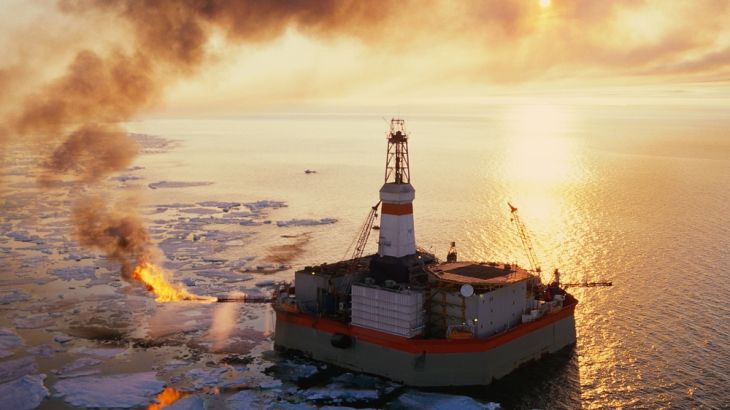
Oil in the Arctic
What are the potential risks of oil drilling in the Arctic and how prepared is the world to handle a catastrophic spill?
For years, the Arctic has been a frontline in the battle over the future of energy and climate change.
Temperatures in the Arctic are rising twice as fast as the rest of the world and the sea ice is melting due to the carbon emissions in the atmosphere. This is allowing companies to search for fossil fuels in the Arctic – which is believed to hold 13 percent of the world’s undiscovered oil.
Keep reading
list of 4 itemsAfter the Hurricane
World’s coral reefs face global bleaching crisis
Why is Germany maintaining economic ties with China?
In July 2015, Shell began a controversial journey to the Arctic. Its mission was to drill and explore in the Chuckchi and Beaufort seas, hoping to find that untapped potential.
The stakes were high for the company – and the environment. But what are the potential risks of oil drilling in the Arctic? And what would happen in the event of an Arctic spill?
Oil spill response in the Arctic
While Shell made its way up north, TechKnow travelled to the Arctic circle aboard the US coastguard icebreaker Healy. It’s one of only two coastguard ships built to handle polar ice, and it will probably play a major role in responding to a disaster.
“If there were a spill, Healy’s position would be to provide access, we can be the operational commanders,” says Captain Jason Hamilton, commanding officer at USCGC Healy.
Scot Tripp, chief scientist at USCGC Healy, looks into oil spill response in the Arctic.
“Everything up here is abnormal for the coastguard … We do all kind of oil research … how to store it, how to move it, just about every aspect. The coastguard is really good at recovering oil in the water, but we have that ice water interface that really hadn’t been approached much. And up here it’s a common occurrence,” Tripp says.
There are several currently accepted methods for dealing with oil spills in open water: Skimming, in-situ burning, and the use of chemical dispersants. None are perfect under the best of conditions, and as TechKnow found, the efficacy of these techniques is being questioned for use in the frigid Arctic waters.
Industry and academic researchers agree, mechanical skimmers can be a viable option, but only if the ice doesn’t keep them from contacting the oil.
“When you do a mechanical clean-up, it’s great if you can remove 10 percent of the oil that spilled … In reality, for example, in the [2010] Deepwater Horizon [oil spill] less than 6 percent of the oil was collected by all of those skimmers and booms that were deployed, and you can imagine what that would be like in the Arctic,” says Nancy Kinner, the director at the Centre for Spills and Environmental hazards at the University of New Hampshire.
![Oil from the BP Deepwater Horizon spill floats on the water off the coast of Louisiana [Charlie Riedel/AP Photo]](/wp-content/uploads/2016/09/c71a4fc977f4483dac02ee1131383bbb_18.jpeg)
In most large spills, like BP’s 2010 Deepwater Horizon blow out, only a small percentage of oil is mechanically removed from the environment. Most of the oil is typically burned off, in a process called in-situ burning, or dispersed into the water either by nature or by the help of chemical dispersants.
“In the Arctic, those are your main human interventions, that can occur and both of those have pros and cons, and what you are trying to do is figure out what the least bad thing is,” Kinner says.
Burning creates smoke that is toxic, and leaves residue that can sink and potentially harm marine life, while dispersants are designed to break the oil down into tiny droplets which diffuse into the water. But research shows that even trace levels of crude oil can be toxic to fish embryos.
Another option is letting nature deal with the oil through biodegradation.
“This is a relatively slow process, in the cold temperatures that we see in the Arctic so that also can be a very slow and long-term process. It’s all a trade-off, if you have oil accumulating at the surface, you have birds, marine mammals that could come up through that oil, and that can be very problematic … The question is, what are the impacts of those dispersants and how efficient are they? And what could potentially happen to public health and to seafood safety?” Kinner says.
TechKnow also finds out how a new technology measuring air samples in the Arctic can detect an oil spill before a satellite.
![The drilling unit Kulluk sits grounded 64 kilometres southwest of Kodiak City, Alaska [US Coast Guard/Petty Officer 2nd Class Zachary Painter/Handout/Reuters]](/wp-content/uploads/2016/09/0668b7454ff4433f98982f4588174876_18.jpeg)
The realities of oil: Drilling in the Arctic
States such as Alaska, however, depend on oil to keep their state running, and about 85 percent of its budget is supplied by oil revenues.
“There’s been drillings done in the Arctic for years, successfully,” Denise Michels, mayor of Nome, Alaska, explains. “If an oil spill happens … the companies doing the drilling are supposed to have assets in place to control that. But the reality is our weather is unpredictable, and so it’s any marine activity happening in the Arctic, that we are concern about.”
“I think living in Alaska you become quite aware of the realities of oil. It brings a tremendous number of benefits… we have to find a way to live with it. But on the other hand, we can’t go back if we have a significant accident. There would be long-term implications, and the people that are on the frontlines are the people living here in the Arctic,” says Andy Mahoney, a geophysicist.
So is Arctic drilling inevitable? And what will be the future of the Arctic – and the planet – if companies are still determined to find the oil hidden in the Arctic?